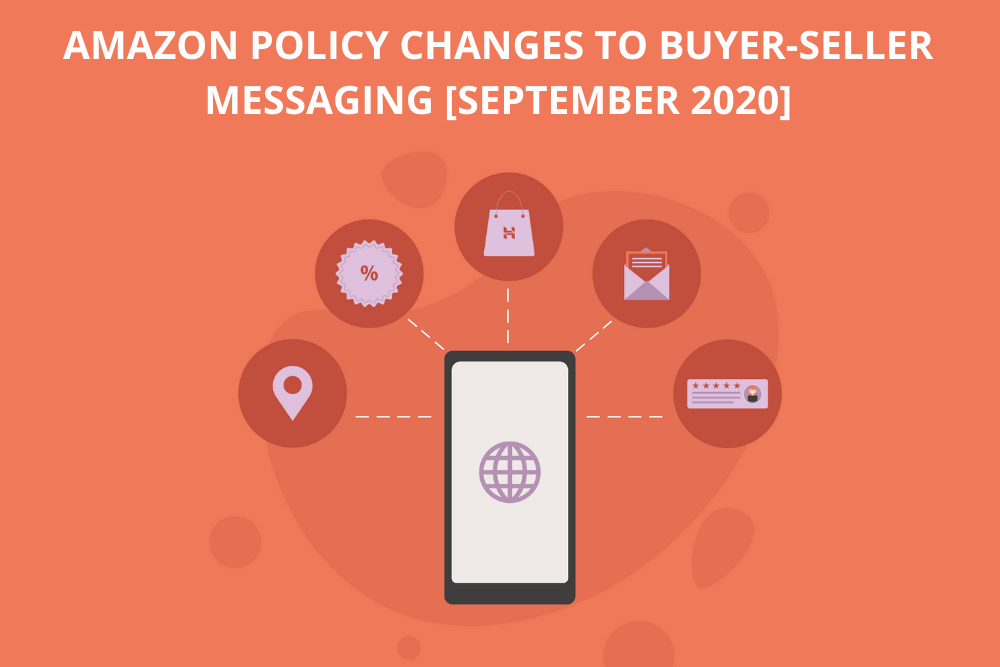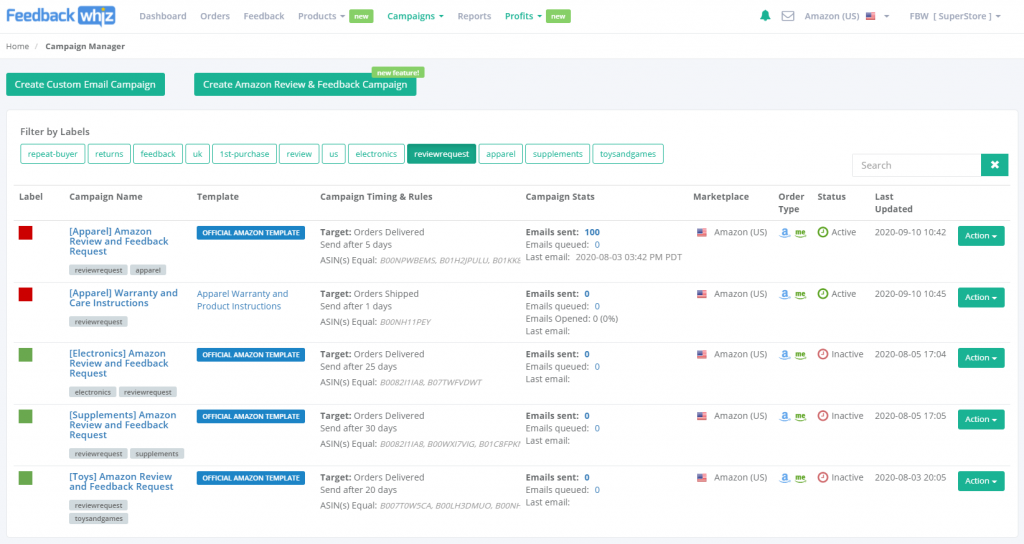
Amazon is always making tweaks and adjustments to its Terms of Service. Sellers that use the platform are responsible for keeping up with all of these changes and complying with the guidelines that are put in place. To that end, Amazon just released a statement with updates to its buyer-seller messaging communication guidelines that will go into effect on November 3, 2020. We’re here to break down these Amazon buyer-seller messaging changes so that you can understand them and make the proper adjustments moving forward.
Amazon Buyer-Seller Messages That Are Allowed
Amazon’s new communication guidelines break down permitted forms of direct communication between the seller and the buyer into two categories; “Necessary Permitted Messages” and “Proactive Permitted Messages”. All permitted messages must be sent within 30 days of the original order.

Necessary Permitted MessagesThese types of communications are deemed necessary to complete an order. They include: |
Proactive Permitted MessagesProactive Permitted Messages are messages initiated by the seller that are not responses to a buyer’s inquiry. They include: |
|
• Problem with Order Messages – If a seller is having an issue fulfilling the buyer’s order in a timely manner, they will be expected to use messaging to update the customer on these issues • Return-related Messages – Returns should be handled in the “Manage Orders” section on your Amazon’s Seller Central page. In the event that you need additional information to complete a return or you are offering a partial return, you may use messaging to communicate with the buyer |
• Resolving an issue with order fulfillment • Requesting additional information required to complete the order • Asking a return-related question • Sending an invoice • Requesting product review and/or seller feedback • Scheduling delivery for a heavy or bulky item • Scheduling a Home Services appointment • Verifying a custom design • Any other reason where the contact is required for the buyer to receive the purchase |
| Both of these communication types are order specific and can only be sent through your seller account on Amazon’s Seller Central. | |
It is important to note that under Amazon’s new guidelines, “requesting a product review and/or seller feedback” is still permitted. Sellers can now determine if they want to use buyer-seller messaging or the Amazon request a review button to ask buyers for reviews. They can manually send these out via Seller Central, use third-party applications in the Application Store, or via Application Programmer Interface (API).” This means that third-party services like FeedbackWhiz can still be used to generate feedback and review requests.

Amazon Buyer-Seller Messages That Are No Longer Permitted
In addition to mapping out what type of messaging is permitted, Amazon went into detail on the types of messages and elements within those messages that will no longer be allowed.
Types of Messages No Longer Permitted
Here’s a list of the types of buyer-seller messages that will not be permitted moving forward:
• Order or shipping confirmations
• Messages that say only “Thank you” or that you are here to help if buyers have any problems
• Marketing or promotional messaging, including coupons
• A repeat request (per order) for a product review or seller feedback
One of the goals of Amazon’s new guidelines is to cut down on the amount of messaging that its buyers receive. Since Amazon already sends out automatic order and shipping confirmations, it doesn’t want the seller to do the same. And while one request for a product review or seller feedback per order will be permitted, follow-up messages and requests will not be allowed.
Elements That Permitted Messages Can Not Include
When sending permitted messages to buyers, none of the following elements can be included within these messages:
• Language that either incentivizes or persuades the buyer to submit positive product reviews or seller feedback, including by offering compensation, money, gift cards, free or discounted products, refunds, rebates or reimbursements, or future-benefits
• Language that requests removal or an update of an existing product review
• Language that requests a product review only if they have had a positive experience with the product
• External links unless they are secure working links (https, not http) necessary for order completion or links to Amazon
• Attachments except for product instructions, warranty information, or invoices
• Logos, if they contain or display a link to your website
• Link to opt-out of messaging
• Sensitive content in images or text (e.g. bare skin, violence/gore, adult/offensive language)
• Tracking pixels or images
• Email addresses or telephone numbers
• Images of purchased products as Amazon includes those on your behalf
• Images that do not relate to your brand or company
Many of these rules, especially those on not allowing language that incentivizes positive reviews in any way, were already in place before these new guidelines were released. But it is important to review this list and make sure that your brand isn’t breaking any of these rules, especially when it comes to external links, email addresses, and phone numbers not being permitted.

Styling That Isn’t Allowed in Permitted Messages
Adding GIFs and emojis to your email correspondences used to be a reliable technique in separating your brand from the pack. Unfortunately, those days are over on Amazon. Permitted Messages aren’t allowed to contain any of the following:
• Accessibility issues as specified in the Web Content Accessibility Guidelines from the Web Accessibility Initiative
• Emojis
• GIFs
• Message margins over 20% max-width
• Image or graphic sizes larger than 80% max-width
• Overrides of Amazon’s default line height, font family, or font color
• Fonts in more than three sizes
• Message bodies that are centered or that otherwise override default text alignment settings
• More than two line-breaks (spacing between paragraphs) in a row
• Unsecure images (http instead of https)
• Spelling errors or grammar issues
These changes won’t affect sellers that only use Amazon-built templates for email correspondences. But those that have designed custom templates will need to review and update these templates to make sure that they conform with these guideline requirements.
Importance of Making Your Feedback Requests Count
As Amazon scales back on the number of messages that sellers are allowed to send to buyers and the customization they can use within those messages, optimizing the messages that you are able to send is going to be essential to the long-term success of your email marketing campaigns. FeedbackWhiz is here to help with feedback and review automation.
Amazon’s new policy regarding one review request per order gives you only one chance at converting a sale into a valuable product review on your product. What if you don’t have the time during the busy season to send out those requests, or what if you send them before your customer has had a chance to use the product or too long after they have?
With FeedbackWhiz, we give you the option to automate your review generation using either buyer-seller messaging emails or the “Request a Review” button to trigger exactly when these messages are sent. You can set how long after your customer receives their product that you would like your product review request to be sent. Something like a hat that your customer can try on right when they receive it would likely do well getting a product review request 5-7 days after receiving their item, while a more complicated item like a straightening iron might require a few uses and earn more reviews after 21-25 days. FeedbackWhiz campaigns also give you options to exclude sending requests to blacklisted customers and orders or orders that have been refunded, returned, delayed shipment, and if negative feedback had been already left. Using our proprietary campaign system, you can set up sending a product instruction/warranty email using buyer-seller messaging and also set up a campaign to trigger the Request a Review button for review generation.
And with detailed analytics on all of your campaigns, you will be able to determine exactly what is working and which products need adjustments. With automated product review request services from FeedbackWhiz, you can rest assured that all of your customers are being reached and that you are in complete compliance with Amazon’s new messaging guidelines.
Are you ready to start automating feedback and reviews for Amazon? FeedbackWhiz has all the compliant tools and methods to help you maximize conversions! If you’re not already a FeedbackWhiz user, now is a great time to get started with a 30-day free trial and take your Amazon review email campaign strategy to the next level.


0 Comments